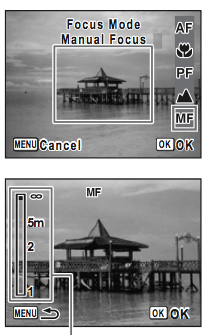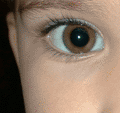|
Pentax Optio V20
Long zoom and large display
(by Conrad H. Blickenstorfer)
In March of 2008, Pentax Imaging Company announced the Optio V20 compact digital camera with a 5X zoom lens, 8.0 megapixels, and a large 3.0 inch LCD monitor. The camera is slim and stylish, and designed to make it easy to capture images in a wide variety of settings and then view them on the large high-resolution display (isn't it interesting how PDA and phone displays get smaller and smaller and camera displays get larger and larger?).

Software plays an ever more important role in digital cameras, and the Optio V20 includes some useful and innovative features. For portrait photography, the V20 helps users optimize pictures with a face recognition function that automatically detects and focuses on faces (up to 15!) and then sets the optimum exposure. Smile Capture detects the key facial expression of happy, smiling people and releases the shutter automatically. Blink Detection reports to the user if a subjects closed their eyes in an image so that the shot can be redone if necessary. Another useful feature is auto-tracking autofocus for continuously focusing on a moving subject (like a running child or a vehicle). The V20 comes with 52MB of built-in memory in case you fill up a card, and there is an Auto-Macro mode that allows macro photography as close as four inches without having to manually change the focus mode.
What you get with the Optio V20
While the Optio V20's large 3.0-inch screen and the big 5X zoom are the primary attractions, what exactly are you getting when you pick the V20? That would be a sleek nd fairly slender 8.0 megapixel ultra-compact weighing under five ounces. The display is large enough to really see pictures, and it is also sharp (230,000 pixel resolution) and has a very wide viewing angle so you don't have to constantly twist the camera to see what is on the screen.
The 5X optical zoom is a definite plus compared to the standard 3X zoom that comes with most cameras. 5X gets you that much closer to the action, and that can make all the difference at sporting events or in any situation where you want to bring things closer or keep a distance so as not to attract attention. Multiply that with the camera's 5.1X digital zoom and you have a total magnification of 25.5X. The V20 also has "intelligent zoom," something that's between "real" optical zoom and digital zoom. Intelligent zoom makes use of unused resolution when you shoot pictures at one of the lower res settings. If you shoot at 640 x 480 VGA resolution, for example, you can get up to 25.5X zoom at significantly better quality than with the digital zoom.
Almost all new cameras have blur reduction or shake reduction these days. That's especially important when you shoot in low light conditions where the camera switches to slower shutter speed or when you use the zoom. The V20 has a digital shake reduction mode for both still pictures and movies. Amazingly, the camera even lets you apply shake reduction after you take a picture.
From a design point of view, the V20 is a very elegant camera with a nicely designed aluminum-alloy housing. Surfaces are a very fine powder-coated silver, and accents are in gleaming chrome. The design language of the V20 is mostly rectangles with rounded edges and corners. In terms of size, the T30 is a compact little box. It measures 3.8 x 2.2 inches and is 0.9 inches thick. That makes it a bit larger than a standard credit card (and also a bit thicker than its Optio V10 predecessor). It's light, too—around five ounces with its Li-Ion battery installed.
Features of the Optio V20
With digital cameras having come down in price so much and with all but the cheapest cameras offering more than enough resolution, manufacturers are scrambling to differentiate their products with special features. Only you can decide which of those features matter to you and which you can do without.
While most serious photographers play around with their pictures in an image processing program once they are uploaded into a PC, the large display of the V20 is conducive to some image manipulation in the camera. The V20, for example, let's you select frames for fun pictures. Use either one of the three standard frames or download as many as 99 frames and save them in the camera. You can still zoom and even move the image around so the subject fits just right.
Pentax is proud of the V20's almost totally icon-based menu system. It does look simple and friendly and it does make the camera easy to use, mostly. Unfortunately, camera menus remain totally unstandardized and you have to get used to a new and different one with almost every camera you pick up. Manufacturers usually try to use the same meny system within their own models, but even there things are not completely consistent. Add to that the fact that today's digital cameras (including the V20) no longer have optical viewfinders and thus rely on you being able to see what is on the LCD display, and things become dicey. One feature that sets most of the Pentax Optio cameras apart is a physical "green mode" button that switches the camera to standard settings. So even if you can't see a thing on the screen, pushing the "green mode" button on the lower left assures that you will get a decent picture.
Controls
Unlike software and menus, the hardware of today's point & shoot cameras has become very standardized, and the Optio V20 is no exception. On top of the camera you find the power switch and the shutter which sits inside the zoom ring. On the back you have the massive display that takes up most of the real estate. A four-way controller disc lets you navigate menues and also lets you change the drive mode (up), flash mode (left), focus mode (right), and capture mode (down). Below it are the "Green" button and the "menu" button. Above it a replay button and the only non-standard one that toggles face recognition on and off.
A nice extra is that the face recognition button also zooms into a face if the image was taken in face reco mode. If there are multiple faces, each push of the button will zoom into a different face.
Power
The Optio V20 uses a small Li-Ion battery. A full charge is good for about 200 pictures, 70 minutes of movie recording or three hours of playback, though that depends on how often you use the big LCD. To charge the battery you need to remove it from the camera and pop it into its charger. Replacement batteries (D-LI78) can be had for between US$15 and 30, so I'd get a spare. The battery cover is on the bottom of the camera, and the battery is securely held in place by a small lever.
Storage/memory
The V20 uses SD cards and the camera supports the higher capacity SDHC standard as well. The camera also comes with about 50MB of internal memory. That can come in handy when a memory card is full, though at full resolution it's only enough for a dozen pictures or so.
Video
You can record movies at 640x480 or 320x240 pixels both at 15 and 30 frames per second. When taking movies, you can also select quality, color mode (black & white, sepia, full color) and movie shake reduction. You can use manual focus in movie mode. You can also use digital zoom durng shooting; optical zoom is available, but only before recording, which is too bad given the cameras nice 5X optical zoom.
Shooting modes
The Optio V20 has a total of 17 different shooting modes.
- Auto Picture -- Automatically picks the best capture mode.
- Program -- Default mode that lets you set arious
functions.
- Night Scene -- Best used with a tripod; benefits from the camera's ability to shoot at very high sensitivity.
- Movie -- Movie mode with sound.
- Voice Recording -- For recording sound only (up to 24 hours worth).
- Landscape -- The camera focusses on a wide range.
- Flower -- Brings out bright colors and softens outlines.
- Natural Skin Tone -- Tries t adjusts color and brightness to accurately reproduce skin colors.
- Portrait -- Brightens skin tones for that healthy, vibrant look.
- Surf & Snow -- Accommodates bright and shiny backgrounds like beaches and snow.
- Sport -- Keeps the camera in focus until the shutter is released to capture fast-moving subjects and action.
- Digital SR (Blur Reduction) -- Switches the camera to higher sensitivity and quicker shutter speed to reduce blur from subject
and camera movement. However, with SR max resolution is just 5 megapixel.
- Pet -- To capturing pets in motion, and there's a special setting
setting to capture a pet's coat (white, gray or black).
- Kids -- Combines capturing moving subjects with face reco and also produces healthy and bright skin tones.
- Food -- High saturation makes food look yummy!
- Digital Panorama -- Stitches three images together to create a panorama.
- Digital Wide -- Combines two images for a simulated wideangle view equivalent to a 28mm lens.
The Optio V20 has a manual focus mode that you operate with the four-way controller disc. When you engage it, the central part of the image is magnified so you can adjust focus (see righthand column).
Sensitivity and other settings
In the olden days of film, one normally shot with 100 or 200 ISO film, and 400 ISO was reserved for low-light conditions where degree of graininess was acceptable. Today's digital cameras can record at significantly higher sensitivity, but always at the cost of extra graininess. The Optio V20 can be manually set to as high as ISO 6400 though the camera only uses 80 to 800 in automatic mode. In the highest settings (3200 and 6400) resolution is set to 5 megapixel. Experiment with the high sensitivity settings to see what degree of graininess is acceptable to you.
Some cameras oversharpen, oversaturate and use other defaults that result in pictures that may not be pleasing to all eyes. The V20 lets you change some of those settings. You can, for example, set image sharpness, color saturation, and contrast to your liking.
Bottom line
The Optio V20 is an 8-megapixel point & shoot camera that offers a number of useful extras. Having a 5X optical zoom lets you get significantly closer to the action. And a high resolution 3-inch LCD display means you can see if a picture is really sharp, and you can enjoy playback. Tricks like face recognition and the ability to wait for smiles and detect eye blink can be quite useful. The high 6400 maximum sensitivity can result in shots that would otherwise not be possible. Not being able to use the optical zoom during movies is a drawback that should be corrected, but it also avoids the constant zooming that mars so many video clips. Overall, the Pentax Optio V20 is a practical, albeit somewhat pricey, camera with a big display and a longer zoom than most.
We like:
- Huge 3-inch wide viewing-angle LCD
- 5X optical zoom
- Plenty of fun and useful software features
- Digital shake reduction with ISO up to 6400
Not so much:
- No optical zoom during movies
- No super-macro
- No sensor shift shake reduction
|
|
|
|
Specifications Pentax Optio V20
|
|
Status
|
Added 07/2008
|
|
Camera Type
|
Ultra-Compact
|
Body
|
Aluminum alloy
|
Size
|
3.8 x 2.2 x 0.9
|
Weight (oz.)
|
4.6 w/o battery
|
Effective Pixels
|
8.0 mp |
CCD Type
|
1/2.35 interline transfer CCD with primary color filter
|
Max pixel size
|
3264 x 2448
|
File formats
|
Still: JPG (EXIF 2.2), DCF 2.0, DPOF, PIM III;
Movie: AVI (Motion JPG);
Sound: WAV (PCM), monaural
|
Compression
|
Best, better, good
|
Movie recording (best)
|
til full @ 30fps
|
Max movie pixels
|
640 x 480
|
Voice recording
|
Record memos til full (24 hour max)
|
Speed
|
Startup: unknown; Release lag: unknown
|
Image stabilization
|
Still: Digital SR Mode, correcting in recorded images; Movie: movie SR Mode
|
Lens
|
8 elements, 6 groups (4 aspherical elements)
|
Focal length
|
6.3-31.5mm (36-180mm equivalent)
|
Zoom (optical/digital)
|
5X/5.1X + "intelligent zoom"
|
Aperture
|
f/3.5 - f/5.6
|
Focus modes
|
9-point AF (multiple, spot, auto), face recogntion AF, macro, infinity, pan, manual
|
Focus macro/normal
|
4 inches, 1.3 feet
|
Shutter speed
|
1/2000 to 1/4 sec.; max 4 seconds in Night Scene mode
|
Sensitivity (ISO)
|
auto/manual 80-6400
|
Autofocus system
|
TTL contrast detection autofocus
|
Metering
|
TTL multi/center/spot
|
White-balance modes
|
auto, daylight, shade, tungsten light, fluorescent light, manual
|
Shooting modes
|
auto/16 modes (Green, Program, Night Scene, Movie, Voice Recording,
Landscape, Flower, Natural Skin Tone, Portrait, Digital SR (Blur
Reduction), Surf & Snow, Sport, Pet, Kids, Food, Digital Panorama,
Digital Wide)
|
Exposure compensation
|
+/-2EV in 1/3 steps
|
Viewfinder Type
|
none
|
LCD size
|
3.0" LCD (230k)
|
LCD type
|
Wide-angle viewable
|
LCD construction
|
fixed
|
Flash type
|
built-in
|
Flash range
|
up to 14 feet
|
Flash modes
|
on, off, auto, redeye, soft flash
|
Camera internal memory
|
51MB
|
Storage Medium
|
SD/SDHC Card
|
I/O
|
USB 2.0/PC/AV
|
Battery type
|
Li-Ion D-L78 (3.7V, 680mAH)
|
CIPA Battery life
|
200 images
|
List Price
|
US$279.99
|
Contact
|
www.pentaximaging.com
|
|
|
Pentax Optio V20 screens
|
|

Above: The Pentax Optio V20 has a manual focus mode. If you engage it, the camera will zoom into the center of the picture so you can adjust the focus via the four-way navigation disc.

Above: The Optio V20 has a shake reduction feature that you can apply AFTER you take a picture. Whilte shooting the picture, the camera apparently record movement and is thus able to apply the best possible after-recording correction.
|
|
|
|
Technology Information
|
|
Inside the CCD
Digital Camera Primer
PictBridge, PIM, Exif, DPOF
Recent advances
|
|
Search
|
|
|
|








